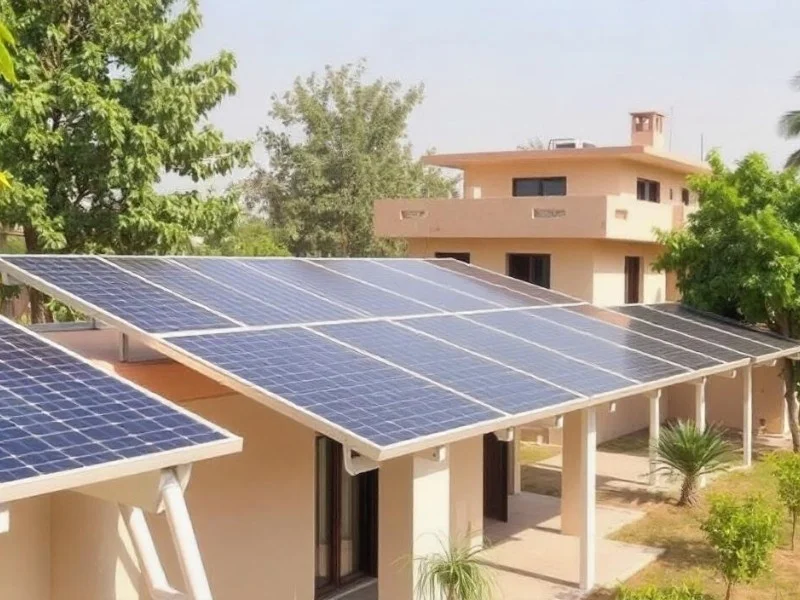Did you know? Solar panels that you see over rooftops and terraces were initially used for space applications to power Satellites. In 1966, NASA launched the world's first Orbiting Astronomical Observatory, powered by a 1 kW solar array. It was only in 1973, that the University of Delaware constructed the first solar building, named "Solar One."
And now in 2025, we see solar panels everywhere on roofs of houses, buildings, factories, schools, hospitals, and many more. But are all those solar panels the same? How many types of solar panels are available in the market? Do all solar panels generate the same amount of energy? What is the best type of solar panel for your roof?
Let us answer all the questions on the types of solar panels in India in this blog.
Researchers are constantly working on innovations in Solar PV technology to improve efficiency, durability, and affordability. In this blog, we will focus on the most commonly available and widely used types of solar panels. Our goal is to help you better understand these options as you consider installing solar for your home or office. We'll also give a quick rundown of some different types of solar panels also, just to keep things interesting!
We know installing solar requires significant upfront investment and some understanding of the system, and we are here to assist you. Feel free to contact us at connect@aerem.co or simply fill the contact form and we will ensure you get your solar loans at attractive interest rates and have a hassle free solar journey.
The most common solar panels in India, you find are rectangular-shaped solar panels sized which are either blue or black. Let us figure out the different types of solar panels available.
Types of Solar Panels
Crystalline Solar Panels – Polycrystalline and Monocrystalline Solar Panels
Now, whenever you request a quotation from a solar EPC company, the first component mentioned in the bill of materials is the solar panel. In 99% of cases, it will either be a Monocrystalline or a Polycrystalline solar panel.
But wait before we know the types, what are Crystalline solar panels?
Crystalline solar panels are made from silicon. Crystalline solar panels consist of thin layers of silicon wafers and other rare materials to absorb sunlight and generate electricity. From this material, either single crystal bowls are prepared by Czochralski method or Multi crystalline blocks by casting technique.
Crystalline solar panels are more affordable than other types of solar panels like thin film solar panels. They are more efficient and suitable for a wide array of uses in commercial, industrial, and residential applications at a much cheaper price. Moreover, crystalline solar panels are more durable which make it apt for extreme temperature variations.
Now coming to polycrystalline and monocrystalline solar panels, itis the manufacturing process that differentiates those two types of solar panels that also results in differences in efficiency, performance, and cost.
Monocrystalline Solar Panels
Manufacturing
Monocrystalline solar panels are made from a single large block of silicon, which is then cut into thin wafers. These silicon wafers are attached to the solar panels during the manufacturing process. The process of making monocrystalline solar panels is called the Czochralski Process. Producing individual monocrystalline wafers requires more labour, making them more expensive to manufacture compared to polycrystalline cells.
Efficiency
Monocrystalline solar panels are more efficient than polycrystalline panels and offer better performance in higher temperatures, with efficiency in newer solar panels ranging from 20-22% in real-world conditions. It is also expected to increase with developments in technology and innovation.
Appearance/Color
Monocrystalline solar panels have uniform black appearance and the rounded edges squares with small spaces between each cell.
Temperature coefficient and Effect of Temperature on solar panels
It is a general misconception/myth that the hotter a place, the better will be the solar generation. However, solar panels work when they receive sunlight, heat generated by the sun can result in a reduction in the solar panel performance. That is when the temperature coefficient comes into picture. The temperature coefficient is a measurement of how well the solar cell functions when the temperature rises. In other words, it indicates the efficiency loss for every degree the temperature rises.
Most monocrystalline solar cells have a temperature coefficient of around -0.3% / C to -0.5% / C. So, when the temperature rises 1°C,the monocrystalline solar cell will temporarily lose 0.3% to 0.5% of its power output.
Lifetime
Monocrystalline solar panels usually have a degradation rate of 0.5-0.8%. In 10 years, the system will operate at ~95% output, and manufacturers typically provide warranty for this linear performance also. Most monocrystalline solar panels come with 25-30 years of Performance warranty and 10-12 years of product warranty.
Cost
Manufacturing monocrystalline solar cells is very energy-intensive and produces a large amount of silicon waste leading to monocrystalline panels being expensive compared to polycrystalline. But considering the higher rating of solar panels available that can fit more capacity in the same area and the overall returns from the solar power plant makes monocrystalline a very viable choice.
Polycrystalline (Muti-crystalline) solar panels
Manufacturing
Polycrystalline solar panels also contain silicon cells like monocrystalline panels. Many silicon molecules are melted and then re-fused together into the panel itself instead of being formed in a large block and cut into wafers like monocrystalline panels. These panels are made from many different silicon fragments from the molten instead of a single pure ingot hence the name Polycrystalline or Multi-crystalline.
Efficiency
Because each polycrystalline cell is made of too many crystals, there is less room for electrons to move resulting in a lower electricity generation efficiency. Most polycrystalline PV cells have efficiencies between 13% to 16%. The efficiency is still good; however, the industry trends are moving towards monocrystalline solar panels.
Appearance
Polycrystalline panels look bluish in colour because of how sunlight interacts with the multi-crystalline. Moreover, because polycrystalline wafers aren’t cut from cylinders like the monocrystalline ones, they won’t have rounded edges.
Effect of Temperature on solar panels
Polycrystalline PV cells can have slightly higher temperature coefficient than the monocrystalline ones. This means that polycrystalline panels will lose more of their efficiency temporarily when the temperature rises.
Lifespan
Polycrystalline PV cells have a slightly higher degradation rate, which causes them to lose their efficiency alittle faster than the monocrystalline ones. However, the product and performance warranty may remain more or less the same. Typically, manufacturers provide 10 years of product warranty and 25 years of performance warranty.
Cost
The manufacturing process creates less waste and uses less energy resulting in less production costs for polycrystalline solar panels. Although Polycrystalline solar panels are cheaper it is important to note that they are usually not manufactured with higher ratings, they occupy more space than monocrystalline to generate the same amount of energy making them less space-efficient.
Here's a quick summary comparing both types of solar panels. You can reach out to Aerem’s, SunStore to find out the latest solar panels available.
Thin Film solar panels
As the name suggest, these panels are thin like a paper or film and are super flexible. They are typically made either of Silicon, or Cadmium Telluride(CdTe) or Copper Indium Gallium Selenide (CIGS). Thin film solar panel can have efficiency between 7-18%. These panels are also less affected by high temperatures. Thin-Film cells have a short lifespan of 10 to 20 years or even less. Considering its flexibility and low cost, thin films solar panels are integrated into products and places like building facades, cars, buses, trains, and bicycles, smartphones, tablets, e-book readers, and smartwatches.
Bifacial panels
Bifacial solar panels consist of solar cells on both sides of the panel. With two faces capable of absorbing sunlight, bifacial solar panels can be more efficient than traditional solar panels. However, for these types of panels, manufacturers recommend a ground clearance of 1.2 to[R1] 1.3 m for optimized results so that the reflected sunlight is captured by the back side of the solar panels or on elevated so structures. Installing in flush mounting style is not recommended as in flush mounting style, there is no space reflected sunlight to reach the back side of the panel and power is generated only from the front side and not the other side, hence dissolving the purpose of using bifacial solar panels.
Apart from this, the latest developments in commonly available crystalline solar panels also include
- Passivated emitter rear contact (PERC) technology is typically integrated with monocrystalline solar panels. PERC solar cells have an extra layer within the back side of the cell which allows some of the sun’s rays to reflect back into the solar cell, giving them another chance to be turned into energy leading to better efficiency of the solar panel.
- N-type solar panels: Until now, we spoke about solar panels that were P-Type silicon solar cells, N-Type panels use N-Type silicon as the base material. This is less prone to impurities making it purer, resulting in an improved flow of electrons. Hence N-Type panels are more efficient at converting sunlight into electricity.
What is the best type of solar panel for your home or office?
Well, it depends on your budget, area available and the returns you expect.
However, in most cases, space constraint becomes a challenge,hence it is always recommended to go with a solar panel with a higher ratingand efficiency to achieve a higher solar plant capacity and ultimately betterreturns. For example, you can go with a Monocrystalline PERC solar panel withrating => 500Wp.
If space is not any issue, even polycrystalline solar panels will work perfectly fine.
If you are planning to make a gazebo on your terrace for gardening or as a leisure space, you can also think of bi-facial solar panels.
Feel free to check out the latest solar panels available at Aerem’s, SunStore to choose solar panels for your home or office or contact us at connect@aerem.cofor any query regarding your solar installation.

.webp)
.webp)
.webp)


.jpg)







.jpg)




.jpeg)












.jpg)


.png)
.png)
.png)
.png)
.png)
.png)


.png)


.jpg)
